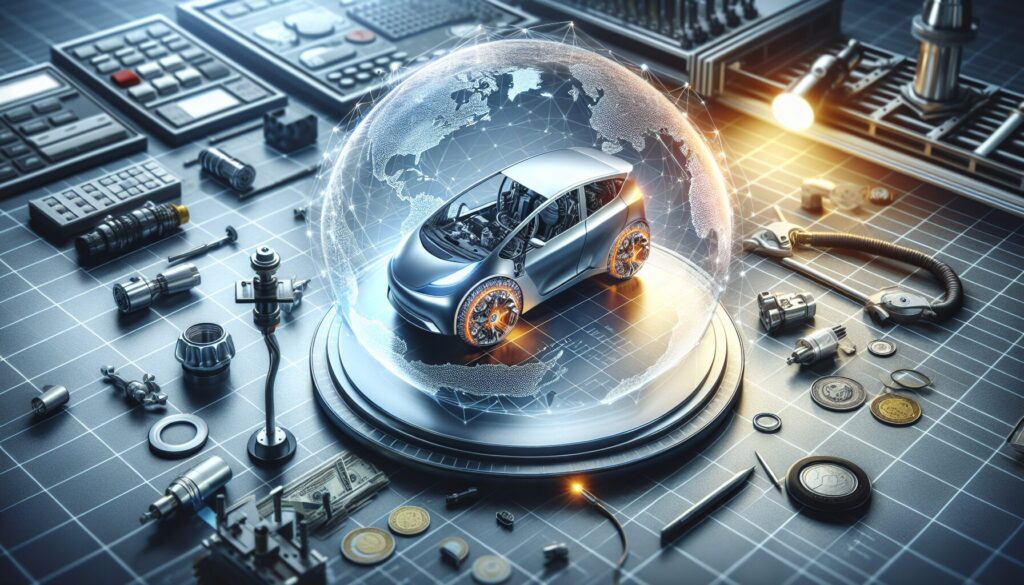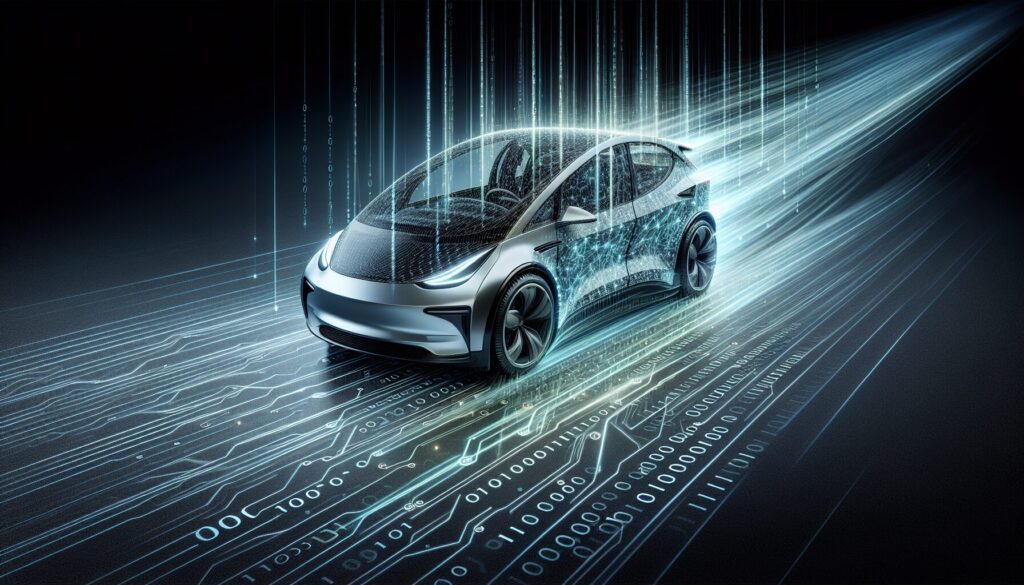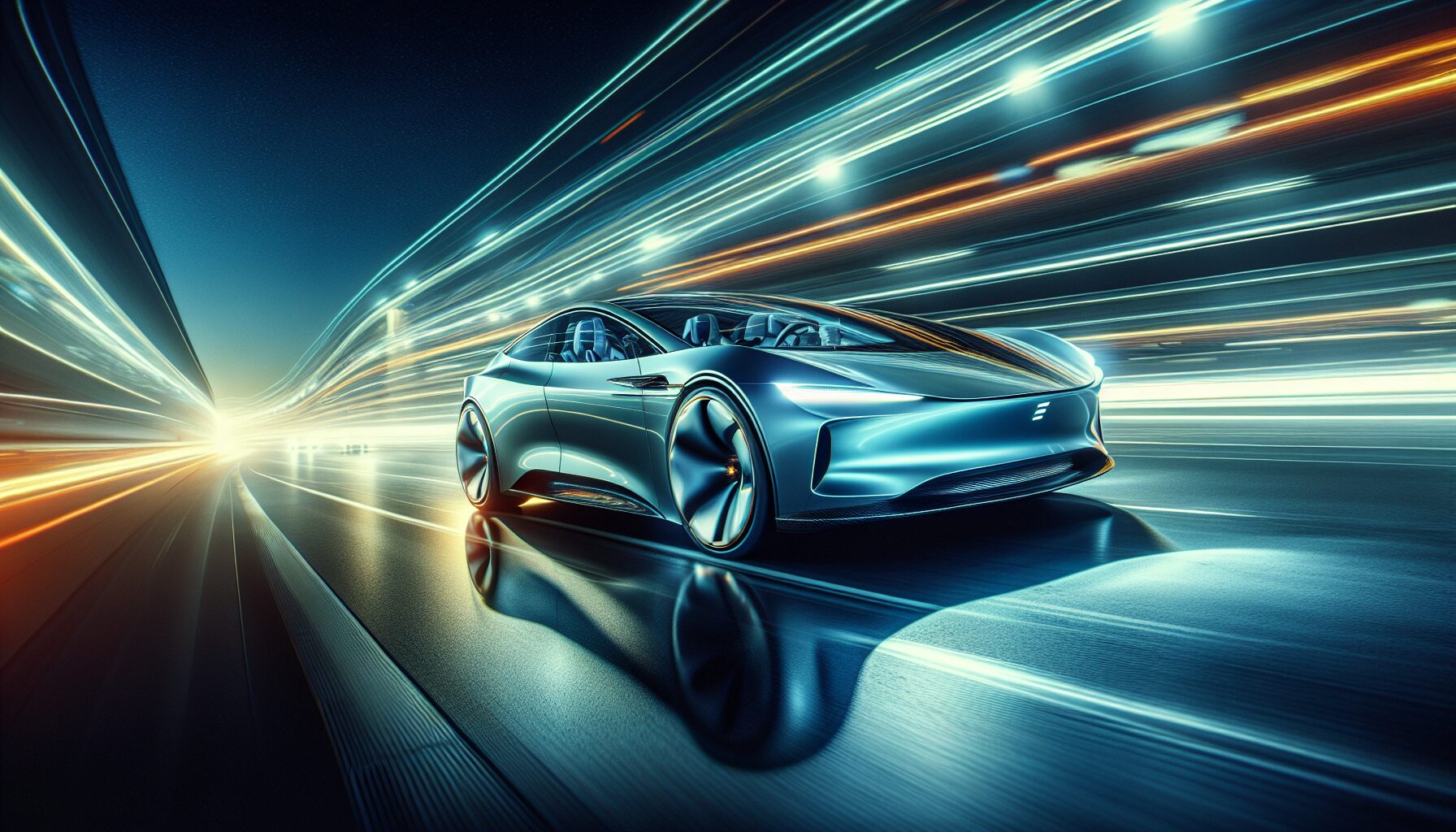It’s essential to grasp the basics of EV aerodynamics to appreciate how these sleek machines glide through the Aussie roads with such efficiency. Aerodynamics is all about how air moves around things, like how a surfer cuts through ocean waves. For electric vehicles, this involves reducing drag, which is the resistance an object encounters while moving through air. Think of it like trying to run against a strong wind; less drag means you can move more easily and use less energy. This is why you’ll notice EVs often have smooth, rounded shapes. They’re designed to cut through the air more efficiently, improving battery life and performance. Additionally, elements like wheel covers and underbody panels help minimize turbulence and drag. By understanding these basics, you’ll see why EV designs are revolutionizing how we think about car efficiency down under!
2. The Role of Shape and Design
The shape and design of electric vehicles (EVs) play a crucial role in their aerodynamic efficiency. Manufacturers are now streamlining these vehicles to reduce drag, which is essentially the wind resistance that slows them down. Think of drag like trying to run against a strong wind; the more streamlined you are, the easier it is to move forward. Therefore, a sleek design isn’t just for aesthetics; it’s about enhancing performance and efficiency on Aussie roads.
When it comes to the design elements that matter most, the underbody of the vehicle is key. By smoothing out the undercarriage, EVs can glide through the air more effectively. This area, often overlooked in traditional cars, is like the soles of your shoes—keeping them smooth helps you move with less effort. Additionally, wheel design is another important factor. Innovative wheel shapes help minimize turbulence, which further reduces drag.
Innovative Design Features
Modern EVs also incorporate advanced features to improve aerodynamics. For instance, retractable door handles and cameras replacing side mirrors are becoming more common. These features reduce protrusions and help the car maintain a streamlined profile. Additionally, some manufacturers, like Tesla, are even experimenting with active aerodynamics. This involves parts of the car moving to adapt to different speeds and driving conditions, much like how birds adjust their wings mid-flight.
All these design considerations not only improve speed and efficiency but also extend the range of EVs, which is a major selling point. As technology evolves, the role of shape and design in EV aerodynamics will continue to be a focal point for innovation and improvements in the automotive industry.
3. Importance of Material Selection

Material selection is absolutely crucial for optimizing EV aerodynamics. The choice of materials can significantly affect the vehicle’s weight and resistance, which in turn impacts efficiency and range. Lightweight materials like carbon fiber and aluminum are often favored. They reduce overall mass, allowing the vehicle to glide more smoothly through the air. Imagine swapping a bulky winter coat for a lightweight rain jacket; you move more freely and easily.
Using advanced composites also helps in reducing drag, a critical factor for EVs on Aussie roads. These materials can be molded into aerodynamic shapes, minimizing air resistance. Carbon fiber, for example, is not only light but also incredibly strong, allowing designers to create sleek profiles without sacrificing durability. Additionally, integrating these materials into the design can lead to improved energy efficiency. A report by ScienceDirect highlights that utilizing such advanced materials can increase an EV’s range by up to 30%.
Benefits of Strategic Material Choices
- Weight Reduction: Lighter materials decrease the energy needed for propulsion.
- Improved Efficiency: Aerodynamic shapes lower drag, enhancing performance.
- Enhanced Range: Less energy consumption leads to longer travel distances.
Furthermore, the environmental impact of these materials is a growing consideration. Many manufacturers, like Tesla, are exploring sustainable options to reduce their carbon footprint. Opting for recyclable or renewable materials supports both performance and sustainability goals. Therefore, choosing the right materials isn’t just about performance; it’s about paving the way for a greener future.
4. How to Utilize Active Aerodynamics
Incorporating active aerodynamics in electric vehicles is a game-changer for optimizing efficiency. These systems adjust the vehicle’s shape in real-time to enhance performance. Think of it like a bird adjusting its wings to glide more smoothly through the air. In Australia, where diverse road conditions are the norm, active aerodynamics can be particularly beneficial.
Active systems can include features like adjustable spoilers and grill shutters. These components dynamically change their position to manage airflow around the vehicle. For instance, a spoiler might rise to reduce drag at higher speeds, improving both speed and battery efficiency. On winding Aussie roads, these adjustments can make your drive both smoother and more efficient.
Key Benefits and Considerations
Understanding the benefits of active aerodynamics can help you make informed choices:
- Improved Efficiency: By reducing drag, these systems can extend your EV’s range significantly, helping you go further on a single charge.
- Enhanced Stability: Adjustments in the vehicle’s aerodynamics can improve handling, especially during high-speed travel or on uneven roads.
- Adaptive Response: As conditions change, active systems respond instantly, optimizing performance without driver intervention.
While active aerodynamics offer remarkable benefits, it’s essential to consider the vehicle’s design and the specific system features. For those keen on diving deeper into these techniques, exploring an expert's guide on EV aerodynamics optimization can provide further insights. In the fast-evolving landscape of electric vehicles, embracing technologies like active aerodynamics is crucial. Manufacturers like Tesla are at the forefront, constantly innovating to enhance EV performance. These advancements not only boost efficiency but also transform the driving experience, making it more engaging and enjoyable for everyone on the road.
5. The Impact of Wheel and Tire Design
Designing wheels and tires can dramatically enhance an EV’s aerodynamics. These elements aren’t just about looking sleek; they play a crucial role in reducing drag and improving energy efficiency. A lot of EV enthusiasts don’t realize how much thought goes into the shape and materials of wheels. Think of them like the wings on a plane, where every curve and surface impacts how smoothly the vehicle moves through the air.
Consider factors like tread patterns. A tire’s tread can significantly affect its grip and how air flows around it. Deep treads are like having hiking boots on a road trip, providing grip but increasing resistance. On the other hand, smoother tires create less drag, similar to wearing sleek running shoes, helping the vehicle glide effortlessly.
Additionally, the materials used in wheel construction matter. Lightweight alloys, such as those from Tesla, help reduce the vehicle’s overall weight. This reduction is akin to shedding extra baggage on a long walk, making the journey much more efficient. Carbon fiber is also common, offering strength without adding weight, much like a well-built yet feather-light structure.
Active Technologies and Future Trends
Active wheel technologies are gaining traction. These systems adjust the wheel’s angle or shape dynamically. It’s like having smart shoes that adapt based on the terrain, optimizing performance and efficiency. This innovation is leading the charge towards more efficient EV designs.
In Australia, where roads can range from perfectly smooth to rugged outback trails, these advancements make a significant difference. They’re not just about saving energy; they’re about enhancing the entire driving experience. As EV technology evolves, keep an eye on manufacturers pushing the boundaries of wheel and tire design to maximize aerodynamics.
6. Innovations in Underbody Design
Underbody design in electric vehicles has become a hotbed of innovation, promising significant improvements in aerodynamics. Let’s dive right into how these advancements are shaping the future of EVs! Many manufacturers are now focusing on streamlining the vehicle’s underside to reduce drag. This is a clever move because a smooth underbody allows air to flow more freely, much like a well-oiled machine operates more efficiently. It’s all about reducing that pesky resistance that can sap energy.
To achieve this, engineers are adopting materials and techniques that enhance the vehicle’s underbody. For instance, lightweight alloys and carbon fiber are frequently used for their strength and minimal weight. Imagine a feather-light shield that protects without weighing you down. These materials not only improve the aerodynamics but also contribute to the overall efficiency of the vehicle.
Advanced Features Revolutionizing Underbody Designs
Several exciting features are making waves in this domain:
- Active aerodynamic components: These are parts of the vehicle that can adjust their position based on speed or driving conditions. Think of them as the flaps on an airplane wing that change to provide the best lift.
- Integrated diffusers: Located at the rear, these help manage the airflow beneath the car, improving stability and performance. It’s like having a guide that directs air in the most efficient path.
- Seamless battery housing: By integrating the battery pack smoothly into the underbody, drag is minimized, enhancing both range and speed. Picture a jigsaw puzzle where each piece fits perfectly, leaving no gaps.
Innovations in underbody design are not only about aesthetics but also about function and efficiency. Companies like `Tesla` and `ScienceDirect` are at the forefront, pushing boundaries and setting new standards. As these advancements continue, Aussie roads will see more EVs zipping by with greater efficiency and style, paving the way for a more sustainable future.
7. How Software Enhances Aerodynamics

Software plays an essential role in boosting EV aerodynamics today, making our electric rides even more efficient on Aussie roads. Advanced simulations and computational fluid dynamics (CFD) are at the heart of this transformation. Think of CFD like a virtual wind tunnel for digital airflows, allowing engineers to refine vehicle shapes without physical prototypes. This tech helps predict how air moves around an EV, identifying ways to reduce drag and enhance performance.
Moreover, machine learning algorithms are adding another layer of efficiency. These algorithms learn from vast data sets to optimize real-time aerodynamic adjustments. Imagine a smart assistant that tweaks your car’s settings as you drive, adapting to wind conditions just like a seasoned driver would. This means better energy efficiency and longer battery life. Tesla’s Autopilot system, for instance, uses such intelligent software to improve driving dynamics.
Integration and Innovation
Integration is key when it comes to software-driven aerodynamic enhancements. Many modern EVs feature systems that communicate seamlessly with active aerodynamic components. These systems adjust elements like diffusers and spoilers based on the car’s speed and direction, minimizing air resistance. Additionally, integrated software platforms ensure that all components work in harmony, which is crucial for maintaining optimal performance.
Finally, the role of software in aerodynamics isn’t just about efficiency. It also opens up possibilities for new design innovations. With digital modeling, designers can experiment with bold, futuristic shapes that were once impossible to test efficiently. Companies like ScienceDirect and Active Technologies are leading the way in this field, offering insights and solutions that push the boundaries of what’s possible in EV design.
8. Tips for Improving Your EV's Aerodynamics
Enhancing your EV’s aerodynamics can really make a difference in performance and efficiency, especially on those long Aussie drives. Here are some practical tips to consider:
Streamlining your vehicle is crucial. It involves reducing anything that sticks out or creates unnecessary resistance. Think of it like smoothing out a rough surface to reduce friction. By keeping your car’s exterior clean and simple, you minimize drag.
Next, consider upgrading to low-resistance tires. These are designed to roll more smoothly and efficiently, much like a well-oiled machine. They can help reduce rolling resistance, which is the energy lost as the tire rolls over the road.
Investing in active aerodynamic components can also be beneficial. These are parts that adjust automatically for better airflow, similar to how a bird adjusts its wings to glide more efficiently. Active aerodynamics can significantly enhance your EV’s efficiency.
Additional Techniques to Consider
- Lightweight alloys: These materials reduce the overall weight of your EV, which can improve aerodynamics and efficiency. It’s akin to carrying a lighter backpack on a hike.
- Seamless battery housing: By integrating the battery housing smoothly into the car’s design, you reduce drag. It’s like wearing a fitted suit instead of a loose one, reducing air resistance.
Don’t forget about computational fluid dynamics and machine learning algorithms. These tools can optimize the design and performance of your EV by predicting airflow patterns. They’re like having a weather forecast for your car’s aerodynamic performance. Innovations like Tesla’s Autopilot System and advancements from companies like ScienceDirect in Australia can provide valuable insights into these technologies.
Conclusion
Ultimately, understanding and optimizing the aerodynamics of electric vehicles is key to enhancing their efficiency, performance, and sustainability on the road. From innovative designs to advanced software applications, every aspect of an EV’s structure is meticulously crafted to minimize drag and maximize energy savings. As technology continues to evolve, these aerodynamic innovations will play an even more significant role in shaping the future of transportation. Here’s to smoother, more efficient rides on Australia’s roads!
Continue Exploring
Unlock the secrets to boosting your EV's efficiency and performance with cutting-edge aerodynamic upgrades. Dive into the world of innovation and see how you can transform your driving experience today!
Frequently Asked Questions
What are the most effective aerodynamic techniques for electric vehicles in 2025?
In 2025, the most effective aerodynamic techniques for electric vehicles (EVs) include advanced computational fluid dynamics (CFD) simulations, active aerodynamics with deployable spoilers and diffusers, and the use of lightweight materials to reduce drag. These techniques help improve energy efficiency and increase the range of EVs by minimizing air resistance.
How do computational fluid dynamics simulations enhance EV aerodynamics?
Computational fluid dynamics (CFD) simulations enhance EV aerodynamics by providing detailed insights into airflow patterns around the vehicle. By analyzing these patterns, engineers can optimize the vehicle’s shape and design features to reduce drag and turbulence. This results in improved energy efficiency and better performance for electric vehicles.
Why is active aerodynamics important for electric vehicles in 2025?
Active aerodynamics is crucial for electric vehicles in 2025 because it allows for dynamic adjustments to the vehicle’s shape and airflow management in real-time. Features such as adjustable spoilers and vents can optimize airflow based on driving conditions, reducing drag and enhancing range. This adaptability is particularly important for maximizing the efficiency of EVs as they continue to evolve.


Leave a Reply